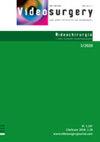Endovascular embolization of arterial bleeding in patients with severe acute pancreatitis
IF 1.6
4区 医学
Q2 SURGERY
引用次数: 7
Abstract
Introduction Severe acute pancreatitis (SAP) has a high mortality rate of 20% to 30%, with death often resulting from hemorrhage. Aim To investigate the role of digital subtraction angiography (DSA) and endovascular embolization in the management of arterial bleeding in SAP patients. Material and methods Seventy-six patients with SAP admitted to our hospital between January 2010 and May 2016 underwent DSA. DSA revealed arterial bleeding in 22 of these patients, who were treated with transcatheter endovascular embolization with coils and/or gelfoam particles. Patient demographics, angiographic features of vascular abnormalities, and outcomes of embolization were assessed. Results Arterial bleeding was the most common vascular abnormality (22/76 patients; 28.9%). DSA enabled the identification of 27 bleeding arteries in 22 patients. The splenic artery was the most commonly affected vessel (11/27; 40.7%). Among the 27 arteries treated with endovascular embolization, successful hemostasis was achieved in 96.3% (26/27). Two patients developed major complications (hepatic and splenic abscess). These patients were treated with abdominal catheter drainage and anti-infection measures and ultimately recovered. The mean interval between initial onset of SAP and angiographic diagnosis of arterial bleeding was 56 days. Rebleeding was diagnosed in 5 patients (5/22; 22.7%) during repeat angiography, with bleeding from new sites in four of these patients. The mean interval between successive angiography treatments was 38 days. Conclusions Endovascular embolization is a safe and effective method to localize bleeding arteries and achieve complete hemostasis in patients with SAP-related arterial bleeding.血管内栓塞治疗重症急性胰腺炎动脉出血
严重急性胰腺炎(SAP)的死亡率高达20%至30%,死亡通常由出血引起。目的探讨数字减影血管造影(DSA)和血管内栓塞术在SAP患者动脉出血治疗中的作用。材料与方法2010年1月至2016年5月我院收治的76例SAP患者行DSA治疗。DSA显示22例患者动脉出血,经导管血管内栓塞线圈和/或明胶泡沫颗粒治疗。评估患者的人口统计学特征、血管异常的血管造影特征和栓塞的结果。结果动脉出血是最常见的血管异常(22/76);28.9%)。DSA能够识别22例患者的27条出血动脉。脾动脉是最常见的受累血管(11/27;40.7%)。经血管内栓塞治疗的27条动脉中,96.3%(26/27)动脉止血成功。2例出现主要并发症(肝、脾脓肿)。这些患者经腹部导尿管引流和抗感染措施治疗,最终痊愈。SAP发病至血管造影诊断动脉出血的平均间隔时间为56天。再出血5例(5/22;22.7%),其中4例患者出现新部位出血。连续血管造影治疗的平均间隔时间为38天。结论血管内栓塞术是一种安全、有效的定位出血动脉、实现动脉完全止血的方法。
本文章由计算机程序翻译,如有差异,请以英文原文为准。
求助全文
约1分钟内获得全文
求助全文
来源期刊
CiteScore
2.80
自引率
23.50%
发文量
48
审稿时长
12 weeks
期刊介绍:
Videosurgery and other miniinvasive techniques serves as a forum for exchange of multidisciplinary experiences in fields such as: surgery, gynaecology, urology, gastroenterology, neurosurgery, ENT surgery, cardiac surgery, anaesthesiology and radiology, as well as other branches of medicine dealing with miniinvasive techniques.

 求助内容:
求助内容: 应助结果提醒方式:
应助结果提醒方式:


